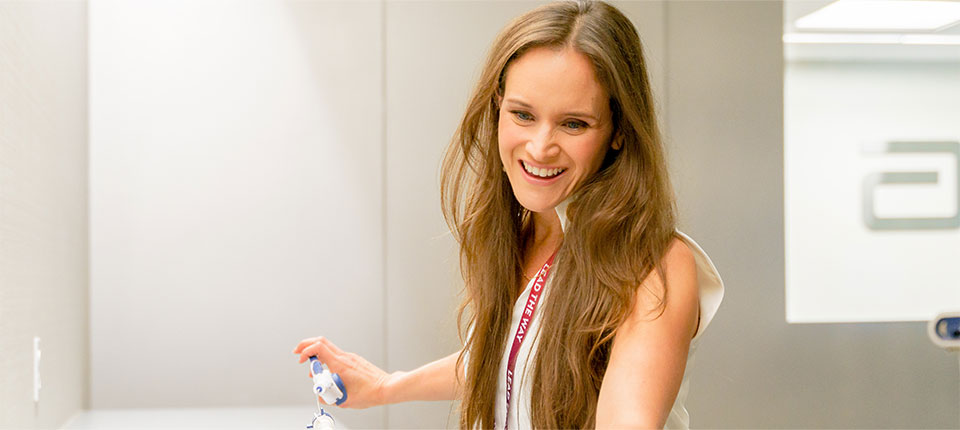
How the Cardiac Rhythm Management Team Stays in Sync
A global team of scientists and clinical engineers use many skills to support those who use cardiac medical devices.
Oct. 21, 2021
- Copy Link
- Share on X
- Share on Facebook
- Share on Linkedin
Working on a team that plays a crucial role in how life-changing health products are used and developed comes with rewards and responsibilities.
Adriana Scott, senior manager of clinical engineering, loves the challenge of using her engineering background to solve complex challenges and interpret solutions for a wide audience of cross-functional STEM teams across Abbott.
Scott's cardiac rhythm management team focuses on implantable medical devices such as pacemakers and heart monitors, as well as structural heart solutions – devices that address conditions like congenital heart defects. These implantable devices are often connected to a patient's smartphone so they can monitor and react to their heart rhythms.
Quantitative and Qualitative
The team focuses on the seamless integration of medical devices into patients' lives, saving them time and effort. This technology allows the devices to collect, analyze and transmit real-time data so physicians and clinicians can monitor their patients' health. The data, as well as users' direct feedback from in-person visits and Q&A sessions, improves the overall patient experience and lets engineers build better next-generation devices, Scott said.
As with a smartphone or an automobile, the cardiac devices are consumer products and must be user friendly, she said.
"With a car, for example, you use the knobs and gears often without taking a close look at them or knowing exactly how they work, but you know how to use them and that you're safe," Scott said. "With our devices, people can't see them but know they are there and working, while being easy and intuitive to use and control."
Tech and Translation
Scott's cardiac rhythm management team members interact with customers, such as physicians, clinicians, and other health care providers, and sometimes with the patients. Then the team works internally with other Abbott teams across the globe, from R&D to sales. Connecting with such diverse audiences requires using scientific training, problem-solving skills, and social skills — as well as understanding the different ways medical professionals, engineers and patients share information, Scott said.
"When we're talking with physicians, we talk about anatomy and treatment protocols or the medical equipment they use," Scott said. "Sometimes they'll articulate a broad need, whether their own or based on patient feedback, and we have to figure out the 'why' behind it.
"I use the example of getting from point A to point B," she said. "We can make you walk, or we can design a bike, a car or a plane, but we need to know the reason you need to get there so we can come up with the right solution. When we take it to the engineers, they have their own language, so we need to be able to tell them the solution is a spreadsheet or a knob or an interactive display."
The global aspect of these interactions also means the team must understand various approaches to healthcare because every country is unique, Scott said.
The Human Factor
In all the conversations about cardiac rhythm management with medical providers, in-house engineers, and tech staff, and among the team, the focus is always on how the devices help medical professionals offer the best possible care to people.
Scott, in addition to leading the broad team, oversees a specialized team trained as "human factor engineers." Design and psychology are big components of the work this team does.
"The human factor is ensuring our products are usable, make lives easier and that the whole Abbott experience is a pleasant and delightful one," she said.
The human factor is essential when the team develops new devices or improves existing ones. For example, when the cardiac rhythm team received feedback that an incision cutting tool should be easier to use, the team consulted with plastic surgeons.
"For the second version of the tool, we talked with plastic surgeons, who are not our main customers, but they cut and stitch and understand it better," she said. "We sent kits with the updated cutting tool to several plastic surgeons, and they gave us feedback on how to improve it for physicians who use it and for patients, who benefit from an easier healing process. It was very interesting and took us outside of our natural customer base to improve the performance and experience."
STEM skills, such as device design or data analytics, contribute to better outcomes for patients by helping medical professionals excel at their jobs and improve care for people. But there is more to the work than hard science.
Scott's team needs to have good listening skills, be in tune with customers’ needs and connect with the human element so they can design products that offer meaningful results for people and provide a sense of purpose for themselves. Scott said she and her team embrace the harder and softer skill sets that are essential to the clinical engineering team because when they do their jobs well, it results in satisfied customers and positive outcomes for people who use the devices.
For the latest on Abbott’s life-changing technology, get updates directly in your inbox.